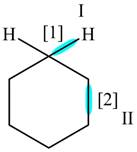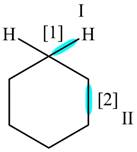
Concept explainers
(a)
Interpretation: The orbitals used to form the indicated bonds are to be predicted.
Concept introduction: The geometry and hybridisation of an atom is determined by the number of group around it. If the number of groups attached to an atom is
Answer to Problem 1.70P
Orbitals used in the formation of given bonds are:
Explanation of Solution
The given compound is,

Figure
In bond
Orbitals used in the formation of given bonds are:
(b)
Interpretation: The orbitals used to form the indicated bondsare to be predicted.
Concept introduction: The geometry and hybridisation of an atom is determined by the number of group around it. If the number of groups attached to an atom is
Answer to Problem 1.70P
Orbitals used in the formation of given bonds are:
Explanation of Solution
The given compound is,

Figure
In bond
Orbitals used in the formation of given bonds are:
(c)
Interpretation: The orbitals used to form the indicated bonds are to be predicted.
Concept introduction: The geometry and hybridisation of an atom is determined by the number of group around it. If the number of groups attached to an atom is
Answer to Problem 1.70P
Orbitals used in the formation of given bonds are:
Explanation of Solution

Figure 2
In bond
Orbitals used in the formation of given bonds are:
(d)
Interpretation: The orbitals used to form the indicated bonds are to be predicted.
Concept introduction: The geometry and hybridisation of an atom is determined by the number of group around it. If the number of groups attached to an atom is
Answer to Problem 1.70P
Orbitals used in the formation of given bonds are:
Explanation of Solution

Figure 3
In bond
Orbitals used in the formation of given bonds are:
Want to see more full solutions like this?
Chapter 1 Solutions
Organic Chemistry
- b. H3C CH3 H3O+ ✓ H OHarrow_forward2. Provide reagents/conditions to accomplish the following syntheses. More than one step is required in some cases. a. CH3arrow_forwardIdentify and provide an explanation that distinguishes a qualitative and quantitative chemical analysis. Provide examples.arrow_forward
- Identify and provide an explanation of the operational principles behind a Atomic Absorption Spectrometer (AAS). List the steps involved.arrow_forwardInstructions: Complete the questions in the space provided. Show all your work 1. You are trying to determine the rate law expression for a reaction that you are completing at 25°C. You measure the initial reaction rate and the starting concentrations of the reactions for 4 trials. BrO³¯ (aq) + 5Br¯ (aq) + 6H* (aq) → 3Br₂ (l) + 3H2O (l) Initial rate Trial [BrO3] [H*] [Br] (mol/L) (mol/L) | (mol/L) (mol/L.s) 1 0.10 0.10 0.10 8.0 2 0.20 0.10 0.10 16 3 0.10 0.20 0.10 16 4 0.10 0.10 0.20 32 a. Based on the above data what is the rate law expression? b. Solve for the value of k (make sure to include proper units) 2. The proposed reaction mechanism is as follows: i. ii. BrО¸¯ (aq) + H+ (aq) → HBrO3 (aq) HBrO³ (aq) + H* (aq) → H₂BrO3* (aq) iii. H₂BrO³* (aq) + Br¯ (aq) → Br₂O₂ (aq) + H2O (l) [Fast] [Medium] [Slow] iv. Br₂O₂ (aq) + 4H*(aq) + 4Br(aq) → 3Br₂ (l) + H2O (l) [Fast] Evaluate the validity of this proposed reaction. Justify your answer.arrow_forwardе. Д CH3 D*, D20arrow_forward
- H3C. H3C CH 3 CH 3 CH3 1. LDA 2. PhSeCl 3. H2O2arrow_forwardPlease predict the products for each of the following reactions: 1.03 2. H₂O NaNH, 1. n-BuLi 2. Mel A H₂ 10 9 0 H2SO4, H₂O HgSO4 Pd or Pt (catalyst) B 9 2 n-BuLi ♡ D2 (deuterium) Lindlar's Catalyst 1. NaNH2 2. EtBr Na, ND3 (deuterium) 2. H₂O2, NaOH 1. (Sia)2BH с Darrow_forwardin the scope of ontario SCH4U grade 12 course, please show ALL workarrow_forward
 Chemistry for Today: General, Organic, and Bioche...ChemistryISBN:9781305960060Author:Spencer L. Seager, Michael R. Slabaugh, Maren S. HansenPublisher:Cengage Learning
Chemistry for Today: General, Organic, and Bioche...ChemistryISBN:9781305960060Author:Spencer L. Seager, Michael R. Slabaugh, Maren S. HansenPublisher:Cengage Learning
